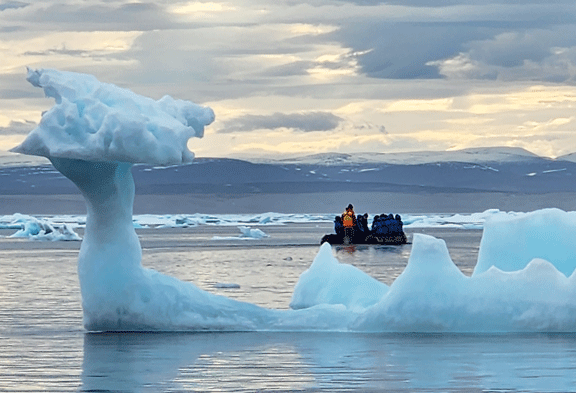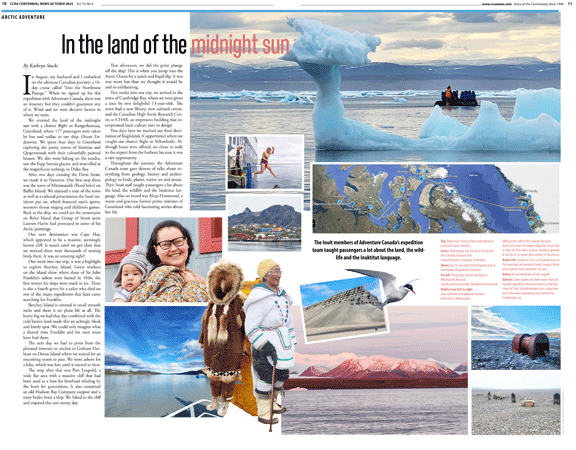
Zodiac tour of the ice floes and icebergs in Lancaster Sound, Nunavut.
By Kathryn Stocks
In August, my husband and I embarked on the ultimate Canadian journey: a 16-day cruise called “Into the Northwest Passage.” When we signed up for this expedition with Adventure Canada, there was a route described but they couldn’t guarantee any of it. Wind and ice were decisive factors in where we went.
We entered the land of the midnight sun with a charter flight to Kangerlussuaq, Greenland, where 177 passengers were taken by bus and zodiac to our ship, Ocean Endeavour. We spent four days in Greenland exploring the pretty towns of Sisimiut and Qeqertarsuak with their colourfully painted houses, went hiking on the tundra, saw a glacier, and marvelled at the magnificent icebergs in Disko Bay.
After two days in the Davis Strait, we made it to Nunavut. Our first stop there was the town of Mittimatalik (Pond Inlet) on Baffin Island. We enjoyed a tour of the town as well as a cultural presentation the Inuit residents put on, which featured men’s sports, women’s throat singing and children’s games. Back at the ship, we could see the mountains on Bylot Island that Group of Seven artist Lawren Harris had portrayed in some of his Arctic paintings.
Our next destination was Cape Hay, which appeared to be a massive, seemingly barren cliff. It wasn’t until we got close that we noticed there were thousands of birds there. It was an amazing sight!
One week into our trip, it was a highlight to explore Beechey Island. Grave markers on the island show where three of Sir John Franklin’s sailors were buried in 1846, the first winter his ships were stuck in ice. There is also a fourth grave for a sailor who died on one of the many expeditions that later came searching for Franklin.
Beechey Island is covered in small smooth rocks and there is no plant life at all. The heavy fog we had that day combined with the cold barren land made this an achingly bleak and lonely spot. We could only imagine what a dismal time Franklin and his men must have had there.
The next day we had one of many pivots from the planned itinerary to anchor in Graham Harbour on Devon Island where we waited for an oncoming storm to pass. We went ashore for a hike, which was fine until it started to sleet.
The stop after that was Port Leopold, a wide flat area that was used as a base for bowhead whaling by the Inuit for generations. It also contained an old Hudson Bay Company outpost. We hiked to a massive cliff and enjoyed this rare sunny day.
That afternoon, we did the polar plunge off the ship! This is when you jump into the Arctic Ocean for a quick and frigid dip. It was way more fun than we thought it would be and so exhilarating.
Two weeks into our trip, we arrived in the town of Cambridge Bay, where we were given a tour by two delightful 13-year-olds. The town had a new library, new cultural centre, and the Canadian High Arctic Research Centre or CHAR, an impressive building that incorporated Inuit culture into its design.
Two days later we reached our final destination of Kugluktuk (Coppermine) where we caught our charter flight to Yellowknife. Although buses were offered, we chose to walk to the airport from the harbour because it was a rare opportunity.
Throughout the journey, the Adventure Canada team gave dozens of talks about everything from geology, history and anthropology to birds, plants, native art and music. Their Inuit staff taught passengers a lot about the land, the wildlife and the Inuktitut language. Also on board was Aleqa Hammond, a warm and gracious former prime minister of Greenland who told fascinating stories about her life.

